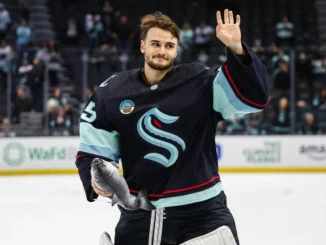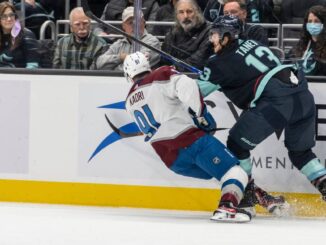
The Seattle Kraken still sit on the outside of the Western Conference playoff picture heading into the seventh week of the 2024-25 NHL season with a record of 9-9-1 (19 points) after 19 games. A wildcard spot is within reach as the team is only a few points away from leapfrogging the Calgary Flames, Edmonton Oilers, and Vancouver Canucks, but with only two games this week (Nov. 20th and 23rd), that jump might have to wait.
The Kraken’s lack of star power has been a running theme throughout the franchise’s existence (Jared McCann is the only skater scoring over a point per game). Still, the team’s fourth line has been pulling more than its weight in a bid to drive play and to allow head coach Dave Bylsma to roll out a balanced forward group.
Related: Seattle Kraken – Is Shane Wright’s Development Trending In The Right Direction?
The Kraken’s forward deployment speaks to the overarching roster strategy. Only one forward plays over 20 minutes per game (Chandler Stephenson), and ten other forwards play between 12 and 18 minutes a night. The range of usage is even tighter at even strength, with 12 forwards playing between 10 and 15 minutes per game. The Kraken are running a score-by-committee approach, one that has reaped mixed results historically in the modern NHL landscape.
It’s because of that equitable usage that numbering lines prove difficult, but Tye Kartye, Yanni Gourde, and Brandon Tanev have combined to create a defensively responsible fourth line with some unexpected offensive punch, becoming the Kraken’s best line at five-on-five in the process. Here are the Kraken’s most commonly used forward combinations sorted by total time on ice (minimum 50 minutes):
| Line | Time on Ice | Goals For-Against | Expected Goals For % |
| Tanev-Kartye-Gourde | 121 | 7-4 | 55 |
| McCann-Eberle-Beniers | 109 | 7-3 | 52 |
| Stephenson-Schwartz-Bjorkstrand | 92 | 0-4 | 45 |
| Burakovsky-Stephenson-Schwartz | 75 | 6-4 | 34 |
Of the four qualified lines, the Tanev-Kartye-Gourde trio leads the Kraken in expected goals per-60-minutes (2.73) and ranks second in expected goals against (2.22) per-60. Compared to qualified lines league-wide, Seattle’s checking line grades out as about average in scoring chance generation but in the top third by chance quality allowed. They thrive on mostly low-event hockey but have thoroughly outplayed their bottom-six opposition.
Kartye’s underlying skill (11 goals last season) and Tanev’s surprising scoring touch (five goals in 19 games this season) have lent themselves to the line’s positive goal margin. An on-ice shooting percentage of nearly 12% and a save percentage (SV%) of .931 suggest that the line’s differential may be slightly padded by shooting luck, but the underlying solid numbers are evidence that play is moving in the right direction when they take the ice and should continue even if the goals stop flowing.
Related: Daccord Should Have Permanent Role As Seattle Kraken’s Starting Goalie
The scoring has been paired with overt – but disciplined – physicality and aggressiveness, which has led to territorial dominance. Kartye (first), Tanev (third), and Gourde (fourth) are among the team’s forward leaders in hits delivered at five-on-five, and Tanev (first) and Gourde (fourth) are also some of the Kraken’s most prolific pickpockets in terms of takeaways per-60-minutes.
The unfortunate byproduct of the line’s rambunctious style is that the forwards are more likely to be penalized. Gourde (four) and Kartye (third) are first and second, respectively, in minor penalties taken, with the former also leading the team with 30 penalty minutes (PIM).
However, intriguing research has been undertaken, which concluded, among other findings, that teams and players who take more penalties are also more likely to have a greater number of penalty calls go their way. With this in mind, it’s not as surprising to discover that Kartye (seven) and Tanev (five) also lead all Kraken forwards in minor penalties drawn at five-on-five and also sport-matching plus-four penalty differentials (drawn minus taken), which are tied for second on the team.
Mainstream hockey analysts underreport the impact of penalty differential, and a high PIM count seems to have only recently taken on a negative connotation in the broader community. Yet, the penalty differential remains a key variable in the creation and discourse around all-in-one, wins-above-replacement statistics within the analytics community and powers the Kartye-Gourde-Tanev line’s overall effectiveness.
Kraken Should Keep Line Together Going Forward
Constructing an NHL roster and fine-tuning lineup optimization is an ever-moving target that is affected by a wide range of variables, including inherent talent, injuries, recent performance, and the organization’s goals and values. When a successful line emerges from the ether and falls into a coach’s lap, it can then feel like a minor miracle.
Bylsma’s objectives as a coach in his first year with a new team, which is rebuilding on the fly while trying to remain competitive, may not include winning a Stanley Cup, but short-term success is a salve that heals all wounds.
Keeping an entertaining and legitimately successful trio by all metrics should be a no-brainer (at least until the trade deadline) for a bench boss looking to capitalize on his newfound NHL lifeline, and is an underrated storyline to keep an eye on going into the second quarter of the 2024-25 season.
Data courtesy of Evolving Hockey, Natural Stat Trick, and the NHL.




